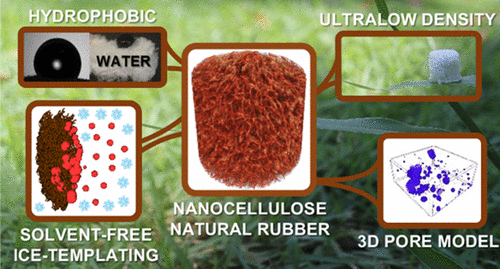当前位置:
X-MOL 学术
›
ACS Appl. Nano Mater.
›
论文详情
Our official English website, www.x-mol.net, welcomes your
feedback! (Note: you will need to create a separate account there.)
Porous Cellulose Nanofibril–Natural Rubber Latex Composite Foams for Oil and Organic Solvent Absorption
ACS Applied Nano Materials ( IF 5.3 ) Pub Date : 2020-10-14 , DOI: 10.1021/acsanm.0c02203 Marcos V. Lorevice 1 , Eduardo O. Mendonça 1 , Naíma M. Orra 1 , Antonio C. Borges 1 , Rubia F. Gouveia 1, 2
ACS Applied Nano Materials ( IF 5.3 ) Pub Date : 2020-10-14 , DOI: 10.1021/acsanm.0c02203 Marcos V. Lorevice 1 , Eduardo O. Mendonça 1 , Naíma M. Orra 1 , Antonio C. Borges 1 , Rubia F. Gouveia 1, 2
Affiliation

|
Nanocellulose-based foams are widely used as absorbents due to their highly porous networks and large surface areas. However, their inherent hydrophilicity and poor wet resilience limit their applications in water remediation for the removal of hydrophobic components (e.g., oil and organic solvent spills). A straightforward process combining biomass-derived materials, cellulose nanofibrils (CNFs), and natural rubber (NR) latex, in the absence of any organic solvent, is herein elucidated to design eco-friendly hydrophobic foams. NR acts as an anchoring filler within the CNF three-dimensional (3D) network, tailoring the production of CNF foams with tunable morphologies, interconnected walls, specific surface areas (∼226 m2·g–1), and higher porosities (more than 92%). Aqueous NR and CNF dispersion exhibited great colloidal stability (ζ-potential above −30 mV), a desirable characteristic to obtain controlled structures. The spherical shape of NR (diameter of ca. 500 nm) and the fibrous morphology of CNF, both by themselves and when mixed, were evidenced by cryogenic transmission electron microscopy. The porous architecture built up through ice templating was corroborated by scanning electron microscopy and 3D X-ray microtomography (μCT). The CNF 3D network and NR promoted rigid and robust foams with elevated compressive modulus (∼600 kPa, for NR20/CNF80). In situ four-dimensional (4D) μCT revealed an impressive increase in oil uptake—from 44 ± 5 to 90 ± 7%—by foam pores upon NR addition. NR was demonstrated by pore segmentation to be evenly distributed throughout the CNF surface, awarding great hydrophobicity (apparent contact angle of around 100°), excellent and quick oil/organic solvent absorption (above 50 g·g–1 in 3 s), and excellent reusability (20 cycles) for organic solvents and oils. This green material exhibits great capacity of soaking nonpolar molecules, standing out as an environmentally friendly, cost-effective, and promising alternative for water cleanup.
中文翻译:

多孔纤维素纳米原纤维-天然橡胶胶乳复合泡沫,可吸收油和有机溶剂
纳米纤维素基泡沫由于其高度多孔的网络和较大的表面积而被广泛用作吸收剂。但是,它们固有的亲水性和差的湿回弹性限制了它们在水修复中用于除去疏水性组分(例如,油和有机溶剂溢出物)的应用。本文阐明了在没有任何有机溶剂的情况下结合生物质衍生材料,纤维素纳米纤丝(CNF)和天然橡胶(NR)胶乳的简单方法,以设计环保型疏水性泡沫。NR作为CNF三维(3D)网络中的锚固填料,可定制具有可调形态,相互连接的壁,比表面积(〜226 m 2 ·g –1)的CNF泡沫的生产)和更高的孔隙率(超过92%)。NR和CNF水性分散液表现出很大的胶体稳定性(ζ电位高于-30 mV),这是获得受控结构的理想特性。低温透射电子显微镜证明了NR的球形(直径约500 nm)和CNF的纤维形态,无论是它们本身还是混合时都是如此。通过冰模板建立的多孔结构通过扫描电子显微镜和3D X射线显微断层照相术(μCT)得到了证实。CNF 3D网络和NR促进了硬质泡沫塑料的压缩模量(对于NR20 / CNF80,约为600 kPa)。原位二维(4D)μCT显示,添加NR后,泡沫孔可显着提高吸油率,从44±5增至90±7%。NR通过孔隙分割证明在CNF表面均匀分布,具有极强的疏水性(表观接触角约100°),极好的和快速的油/有机溶剂吸收能力(在3 s内超过50 g·g –1),并且对有机溶剂和油具有极好的可重复使用性(20个循环)。这种绿色材料具有吸收非极性分子的强大能力,是环保,经济高效且有望用于水净化的替代产品。
更新日期:2020-11-25
中文翻译:

多孔纤维素纳米原纤维-天然橡胶胶乳复合泡沫,可吸收油和有机溶剂
纳米纤维素基泡沫由于其高度多孔的网络和较大的表面积而被广泛用作吸收剂。但是,它们固有的亲水性和差的湿回弹性限制了它们在水修复中用于除去疏水性组分(例如,油和有机溶剂溢出物)的应用。本文阐明了在没有任何有机溶剂的情况下结合生物质衍生材料,纤维素纳米纤丝(CNF)和天然橡胶(NR)胶乳的简单方法,以设计环保型疏水性泡沫。NR作为CNF三维(3D)网络中的锚固填料,可定制具有可调形态,相互连接的壁,比表面积(〜226 m 2 ·g –1)的CNF泡沫的生产)和更高的孔隙率(超过92%)。NR和CNF水性分散液表现出很大的胶体稳定性(ζ电位高于-30 mV),这是获得受控结构的理想特性。低温透射电子显微镜证明了NR的球形(直径约500 nm)和CNF的纤维形态,无论是它们本身还是混合时都是如此。通过冰模板建立的多孔结构通过扫描电子显微镜和3D X射线显微断层照相术(μCT)得到了证实。CNF 3D网络和NR促进了硬质泡沫塑料的压缩模量(对于NR20 / CNF80,约为600 kPa)。原位二维(4D)μCT显示,添加NR后,泡沫孔可显着提高吸油率,从44±5增至90±7%。NR通过孔隙分割证明在CNF表面均匀分布,具有极强的疏水性(表观接触角约100°),极好的和快速的油/有机溶剂吸收能力(在3 s内超过50 g·g –1),并且对有机溶剂和油具有极好的可重复使用性(20个循环)。这种绿色材料具有吸收非极性分子的强大能力,是环保,经济高效且有望用于水净化的替代产品。











































 京公网安备 11010802027423号
京公网安备 11010802027423号